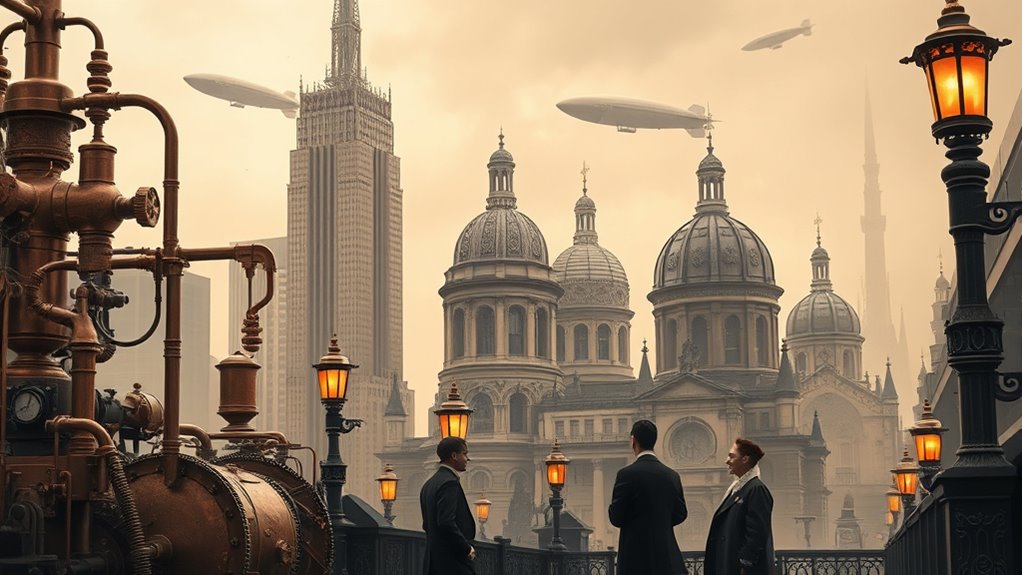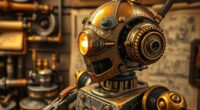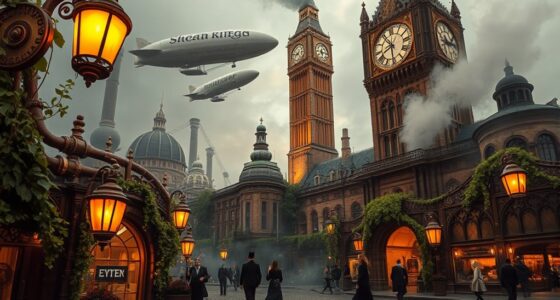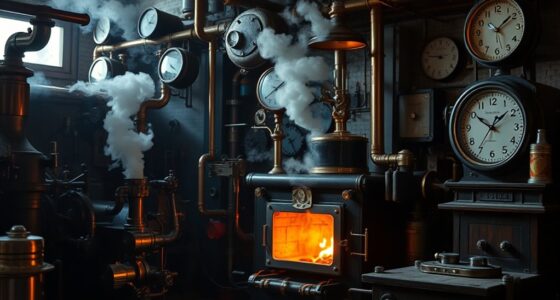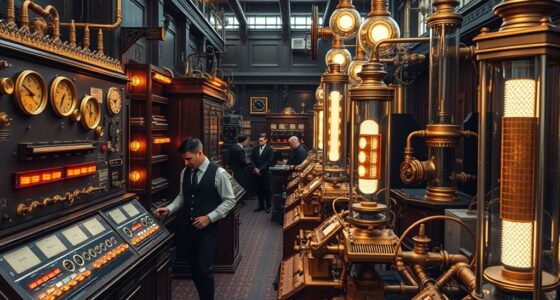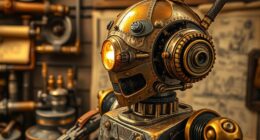Victorians imagined a future filled with beautifully crafted, steam-powered robots and flying cars with elegant curves and elaborate designs. They envisioned machines blending artistry and engineering, often depicted with ornate brass and wood details. These ideas reflected their optimism about progress and a harmonious coexistence between humans and technology. If you keep exploring, you’ll discover how these imaginative visions continue to influence modern notions of innovation and sci-fi.
Key Takeaways
- Victorians envisioned a future with steam-powered robots as elegant, ornate mechanical servants and soldiers, integrating craftsmanship with technology.
- They imagined flying cars as sleek, winged vehicles with intricate propulsion systems, blending artistry with engineering.
- Victorian futurists combined aesthetic beauty and practicality, showcasing detailed, decorative designs in their technological concepts.
- Their visions reflected optimism about progress, emphasizing harmony between humans and machines with a focus on craftsmanship.
- These imaginative ideas aimed to inspire innovation, influencing modern science fiction and highlighting Victorian hopes for a beautiful, advanced future.

Have you ever wondered what the future looked like in the past? During the Victorian era, people imagined a world full of incredible technological marvels that blended the charm of old-world craftsmanship with futuristic visions. These visions often centered around steam-powered robots and flying car concepts, which reflected both the technological optimism and aesthetic sensibilities of the time. Steam-powered robots, for example, appeared in many stories and illustrations as mechanical servants or soldiers, embodying the era’s fascination with steam power and machinery. They weren’t just tools; they symbolized progress and human ingenuity. These robots often had intricate, ornate designs, mimicking the elaborate Victorian style, with polished brass and wood accents. They seemed to promise a future where machines would serve humans seamlessly, transforming daily life and industry. Similarly, flying car concepts captured the imagination of many Victorians dreaming of personal flight. They envisioned sleek, winged vehicles gliding effortlessly through the skies, replacing cumbersome carriages and trains. These flying cars were often depicted with elegant curves, ornate detailing, and elaborate propulsion systems powered by steam or other imagined technologies. The idea of personal flight seemed both thrilling and attainable, sparking stories and illustrations that showed cityscapes filled with airborne vehicles. Victorian futurists believed that advancements in engineering and design would turn these fantasies into reality, and many inventors worked tirelessly to turn these ideas into prototypes or detailed drawings. You might picture Victorian drawings showing flying car concepts with large, ornate turbines or propellers, all crafted with the same intricate detail as their other inventions. These images reflected their desire for technological progress combined with artistic beauty. The fascination with steam-powered robots and flying cars wasn’t just about convenience; it was about creating a future that was both practical and visually stunning. They imagined a world where machines and humans coexisted harmoniously, making life easier while also showcasing artistic craftsmanship. In many ways, these visions reveal how Victorians saw technology as an extension of their artistic sensibilities, blending function with form. Today, these ideas might seem fantastical, but they played a *vital* role in shaping modern concepts of innovation. They remind us that the future, as envisioned in the past, is often a reflection of our hopes, dreams, and values—where technology elevates everyday life and turns science fiction into a fascinating glimpse of possibilities to come.
Frequently Asked Questions
How Did Victorian Aesthetics Influence Futuristic Design Concepts?
Victorian aesthetics heavily influence futuristic design concepts through Victorian steampunk and ornate Victorian ornamentation. You’ll notice how steampunk blends Victorian-era fashion and machinery, creating a nostalgic yet inventive vibe. Victorian ornamentation inspires intricate details, emphasizing elegance and craftsmanship in future tech. This fusion makes your designs feel both nostalgic and innovative, capturing the Victorian fascination with progress while celebrating their love for elaborate, decorative elements.
What Victorian Inventions Anticipated Modern Technology?
You see Victorian inventions like steam-powered automata and the electric telegraph, which anticipated modern technology. Steam automata showcased early robotics, inspiring future automation, while the electric telegraph laid the groundwork for instant communication. These innovations highlight how Victorian inventors envisioned a future driven by mechanization and electrical connectivity, shaping the way we connect and automate today. Their inventive spirit directly influenced the development of contemporary technological advancements.
How Did Victorian Society’s Values Shape Its Futuristic Visions?
You see, Victorian society’s values, like the social hierarchy and gender roles, deeply influence its futuristic visions. They imagined a future where social order remained strict, with technology reinforcing class distinctions. Gender roles also shaped these visions, often depicting women as delicate and nurturing, even in advanced settings. This blend of societal ideals and technological optimism reflects how Victorians envisioned a future that upheld their traditional values.
Were There Specific Victorian Artists Known for Retro-Futuristic Work?
A stitch in time saves nine, and Victorian artists like Lionel Dalhousie and Albert Robida are prime examples of those who shaped mechanical visions with steam-powered imaginations. They crafted detailed illustrations of future worlds, blending Victorian aesthetics with futuristic technology. Their works exemplify how specific artists used their talents to visualize a world fueled by invention, inspiring both their era and modern retro-futuristic designs today.
How Did Victorian-Era Science Fiction Reflect Contemporary Technological Hopes?
You see, Victorian-era science fiction reflects your era’s steam-powered dreams and ornate technological visions. You envision a future where steam engines and intricate machinery transform daily life, inspiring hope and wonder. Through stories and illustrations, you explore possibilities like flying machines, automata, and advanced communication devices, blending imagination with emerging scientific ideas. These tales reveal your optimism about progress, shaping a nostalgic yet visionary image of tomorrow fueled by Victorian ingenuity.
Conclusion
Imagine stepping into a time machine fueled by Victorian dreams—where brass gears and steam-powered visions paint the future. Retro-futurism isn’t just about old ideas; it’s a mirror reflecting our hopes, fears, and endless curiosity. By exploring their imagined futures, you see how today’s innovations are a modern echo of those vintage visions. So, embrace this journey through time, where the past and future intertwine like threads in a rich tapestry, shaping what’s yet to come.
